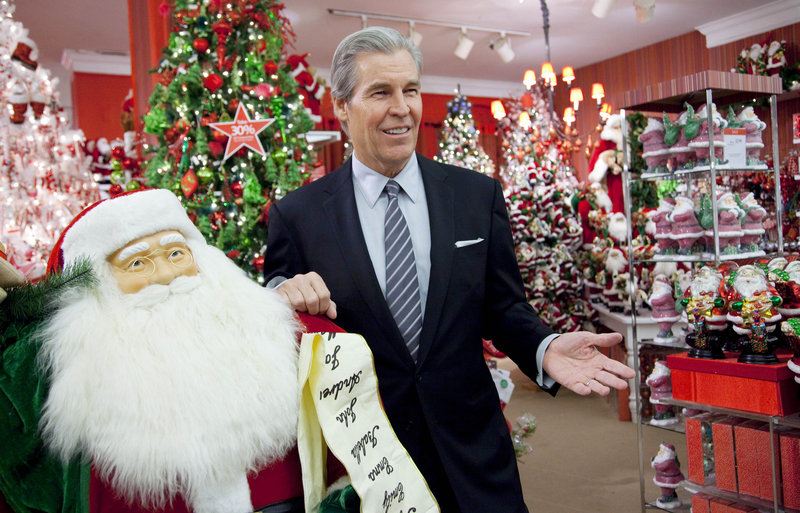NEW YORK – Across the country, Macy’s is ringing in this Christmas with local flavor, from Elvis ornaments in Tennessee to Texas-themed martini glasses.
These 2,200 themed ornaments and other decor sold locally for the holidays are vivid examples of how Macy’s Inc.’s chairman, CEO and president Terry J. Lundgren, 58, is looking to harness the magic of the storied 152-year-old department store chain this Christmas and beyond.
The chain’s latest shift emphasizes local stores’ roots by tailoring merchandise to local markets, he says.
Shoppers are now finding conservative suits in Washington, D.C., and large-size cookware in Utah to cater to larger families, for example. The strategy, rolled out last year to all its stores, has 1,600 district managers in 69 regional districts overseeing merchandise assortments in no more than 12 stores each.
Lundgren, a 35-year retail veteran, conceived of the changes, dubbed “My Macy’s,” as consumer spending was slowing down three years ago. But the financial meltdown made the top executive accelerate the move. That has helped the nation’s second-largest department store chain after Sears Holdings Corp. outperform competitors.
Lundgren expects the local strategy to help revenue at stores open at least a year rise as much as 4 percent in the second half. The retailer said Wednesday that it turned a profit in the third quarter, compared with a loss a year ago.
Lundgren is also focusing on Macy’s exclusive brands to help differentiate the chain from competitors. For the back-to-school season, Macy’s, based in Cincinnati, launched its Material Girl fashion collection, created by pop star Madonna and her daughter Lourdes, which has been a home run. Forty-two percent of its revenue comes from exclusive brands or store labels, Lundgren says.
Lundgren became CEO of Macy’s former parent Federated Department Stores Inc. in 2003. Two years later, he spearheaded the $17 billion acquisition of May, giving the company more than 800 stores.
Macy’s did away with May’s nameplates, from Hecht’s to Marshall Field’s in 2006, causing some anger among shoppers who lost their favorite local store.
Now, Lundgren says Macy’s, which generated $23.5 billion in revenue in its latest fiscal year, is not only holding onto existing shoppers but grabbing more from rivals.
Lundgren says he draws the “My Macy’s” strategy from his experience as a china buyer at the former Bullock’s chain in the 1970s, where he used to load up Lennox plates in his car trunk and travel to 18 stores in southern California.
Here, excerpts from a recent phone interview with Lundgren:
Q: What’s the biggest lesson you learned from the Great Recession?
A: (After the financial meltdown) we just quickly knew there wasn’t going to be a quick response to the consumer and that this was the time to make major changes and to address all the changes that perhaps we were concerned about making. We made structural changes for the better. As we come out of this period … we are clearly benefiting.
Q: You started your retailing career in 1975 as a trainee with Bullock’s. What drew you to retailing?
A: It was the people. … I had 13 job offers. … I took a job for less money at Bullock’s, but I felt if I performed well … I would be more likely noticed (there) because of the attention I received during the interview process.
Q: What was life like growing up?
A: I grew up in Southern California. My father had two jobs; during the day, he worked assembling speakers in a factory. At night and on weekends, he sold real estate. My father was clearly a mentor. He told me if you work 10 years and you worked 40 hours a week, then you had 10 years experience. But if you worked 10 years and you worked 60 hours a week,then you had 15 years’ experience.
Q: Any life experiences that have shaped you as a leader?
A: When I was a sophomore in college my father called me at the fraternity. He told me he had no longer had the funds to pay for college. If I wanted to continue, I would have to do it on my own. I was 19. I figured he was trying to ruin my life. I was the vice president of my fraternity. I wasn’t as focused on my education. I ended up having a job working 40 hours a week. I started out cracking oysters and peeling shrimp. I worked full time and I went to school full time, and I had very good grades. I discovered that the best thing for me was to be very busy all the time. I can get a lot done, and I can do those tasks well. That was a big switch that went off for me.
Send questions/comments to the editors.



Success. Please wait for the page to reload. If the page does not reload within 5 seconds, please refresh the page.
Enter your email and password to access comments.
Hi, to comment on stories you must . This profile is in addition to your subscription and website login.
Already have a commenting profile? .
Invalid username/password.
Please check your email to confirm and complete your registration.
Only subscribers are eligible to post comments. Please subscribe or login first for digital access. Here’s why.
Use the form below to reset your password. When you've submitted your account email, we will send an email with a reset code.